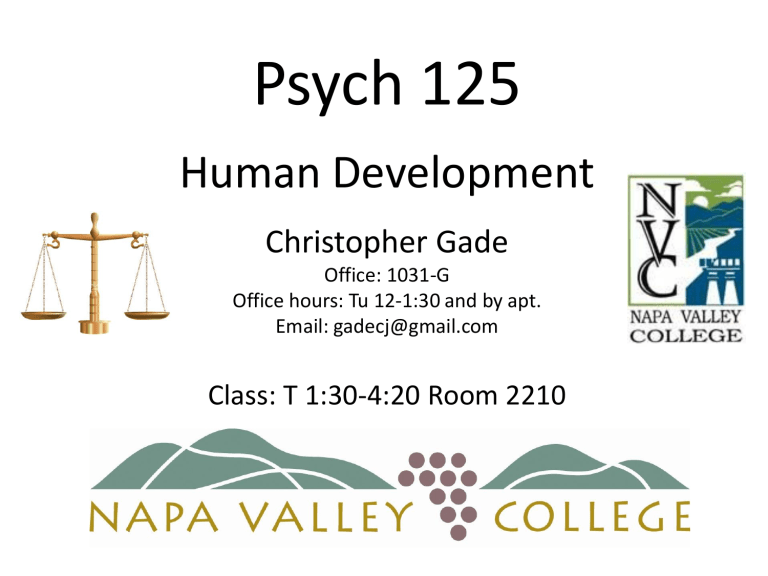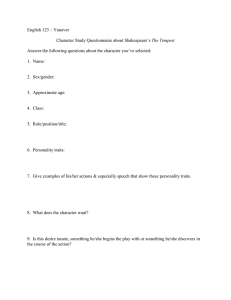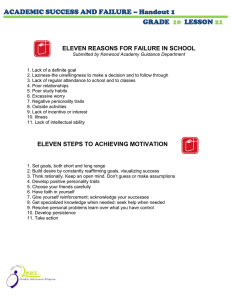Class 11 - Self, Identity, and Personality Development

Psych 125
Human Development
Christopher Gade
Office: 1031-G
Office hours: Tu 12-1:30 and by apt.
Email: gadecj@gmail.com
Class: T 1:30-4:20 Room 2210
Activity:
Defining
“You”
• Lets pretend/acknowledge that you’re single and you’re asked to go out with a friend’s friend on a blind date. Both of you are hesitant to go out on a date with a stranger, so you agree to provide a photograph and a brief description of yourselves before the date. How would you describe “you” to this individual? Write down your description for the next few minutes, and then share it with your neighbor.
• Physical features
• Your Identity – a description of who you are
– Roles
– Likes/dislikes
– History/experiences
• Your Personality – a collection of your enduring characteristics
How did you describe your “self”?
Where did this “self” come from?
• In order to describe ourselves, we first need to recognize that we are a unique individual
– self-recognition
• After that, we need to create a cognitive representation of the things that can identify our “self”, and determine the order of importance in the identifiers
– Self-understanding
The Development of the Self
• Infancy
– Most of this stage of life is spent learning the concept of self-recognition
• Mirror task
• Later developments of “mine” and “not mine”
• Early Childhood
– The “self” is often defined in physical characteristics or skills/abilities
– These descriptions are often inflated “I can run ten million miles”
– Personality descriptors start to emerge later in early childhood
– A theory of mind begins to develop
Self-Related Understanding in Late Childhood
• Psychological and personality characteristics become more prevalent in self descriptions
• Social roles also become important
• Comparative “self” skills develop
• The concept of an ideal self – the person that we’d like to be – becomes integral in the self
• This leads to a more accurate recognition of the self and the ability to differentiate psychological and personality characteristics in others
Self-Development In Adolescence
• There’s a much greater focus on defining the self
• Social comparison becomes extremely important in an attempt to determine an identity
• Possible selves are also often explored
• At the end of this stage, an integration of our ideal self, actual self, and comparative self is often formed–this results in a more stable sense of self
The Self in Adulthood
• As we age, our sense of self becomes more rigid
• This self involves: our current self view, our hoped-for self, and our alternate selves (situation dependent)
• Contradictions in selves become easier to cope with
• Despite this flexibility in understanding and consistency in our perception, our interpretations are usually as accurate as we think
– “The game we talk” often differs from “the game we walk”
– Personal example
• As we get older, we also begin to focus on past selves and a collective self that’s evolved over the years
Self-Related Topics: Self-Esteem
• Self-esteem – our overall self-perception in comparison to others
– Research suggests that self-esteem often changes with age
– Self-esteem has been linked to happiness levels, depression, and perceptions of attractiveness
– It has not been linked to overall ability and well-being
– Our culture displays a very high level of self-esteem throughout life… probably higher than it should be
Self-Related Topics: Self Regulation
• Self-regulation – the ability to control one’s behavior without having to rely on others for help
– Self-regulation is related to committing appropriate behaviors, self-representative behaviors, and self-related environment selection
– Self-regulation abilities vary dramatically across individuals, regardless of their age
– Self-regulation ability is linked to the prefrontal cortex
– Self-regulation is very low during infancy, childhood, and late adulthood
– In old age, self-regulation relates to one type of control
• Primary control – control over selecting our environment
• Secondary control – control over inner world in order to successfully interact with our environment
Looking Closer at the Self
• In the first part of this class, we’ve examined the concept of the “self”
• We’ve looked at how it changes throughout age, and how topics related to the self also develop
• However, we have yet to addressed a key concept; how we decide on what actually defines our self
– Identity – the complete description of the essence of an individual
• Can contain many aspects (work/interests, ideologies, tendencies, past, relationships, associations, desires, etc.)
• Varies across individuals in not only characteristics, but the value of the characteristics
Erik Erikson (1902-1994)
• Born in Germany
• Abandoned by his biological father and adopted by his Jewish step-father
• Was an outcast in both the Jewish community
(for his Nordic appearance), and at school (for being Jewish)
• Probably as a result of this teasing, he became interested in the development of self-identity that we go through in life
The Search For an Identity: Erik Erikson
Erikson Views on Identity
• The question of “who am I” is extremely important to adolescents
– video
• The focus on the past self (generativity versus stagnation) is very important in our older years
• Skipping a stage of identity achievement causes a lot of problems for the individual in their future
• Note: more scientific research has verified that finding an identity in adolescence and focusing on the past during our later years often occurs, but it has also shown that identity realization is a very slow moving and erratic process , with no real culmination in one underlying concept of the “self” at any point
Another Aspect of the Self
• An identity is a very critical aspect of the self, but there is another concept that we often allude to when describing who we are
• Personality – a collection of enduring characteristics
– When we describe personality, we often describe it in
“traits”
– Traits – specific enduring characteristics that can describe an individual’s behaviors across similar situations
– Personality is thought to be stable over time and across situations
– Research on development has shown us a slightly different story
Defining Traits
• When examining traits, personality psychologists have attempted to pinpoint exactly how many traits we have (how many are needed to define and differentiate us)
• Gordon Allport, the first trait psychologist, argued that all of us have a large and unique number of traits that describe us
• Raymond Cattell thought that we had 16 traits that defined each individual
• Current theorists often propose that we have 5 distinct personality characteristics
• But how did we come up with that?
– Five fingers?
– It goes into ten easily?
The Big V
Goldberg’s Lexical Hypothesis Approach
• The dictionary…
– Looked in dictionaries to find every word in the
English language that related to personality
– 18,000 words were found
• Comparing words for synonyms and antonyms…
– Similar to each other (e.g. nice and friendly)
– Opposite of each other (e.g. nice and mean)
– This search reduced the list down to 35 traits
• Conducting “factor analyses” to see which remaining words/traits emerged…
– Found the ones that overlapped with each other in response frequency.
– This reduction left us with a total of 5 personality traits… the big 5.
The Big Five and Development
• Stability in traits over time?
– As we age
• Less neuroticism and openness to experience
• More agreeableness (life) and conscientiousness (in middle age)
• More stability as we age
– Across generations?
• Changes in extraversion and openness over the generations
• The impact of social movements
• Number of traits over time?
– Children
• Sociability and activity
– Harry Potter Study
– Elderly
• Big three?
The Life-Events Approach to
Explaining Personality
• Recent researchers in personality development have argued that stability in personality and the development of specific characteristics isn’t a product of age, but merely a product of the experiences that we encounter (marriage, loss, children, stress, deaths)
• Consistency between individuals is only found because most of us experience the same big events at similar times in our lives
Reviewing Today
• When describing our “self”, development plays a major role in what we use to do that, and our consistency in that message
• We also often incorporate the ideas of identity and personality in this description of the self, both of which are impacted by developmental change
Moving On…
• In the next class, we explore gender and sexual identity in development, please read that chapter before class
• Also, the next assignment and the final paper assignment will be posted at some point during.
Please start planning your papers, the first is due in two weeks, and the second is due the week after the last exam.



